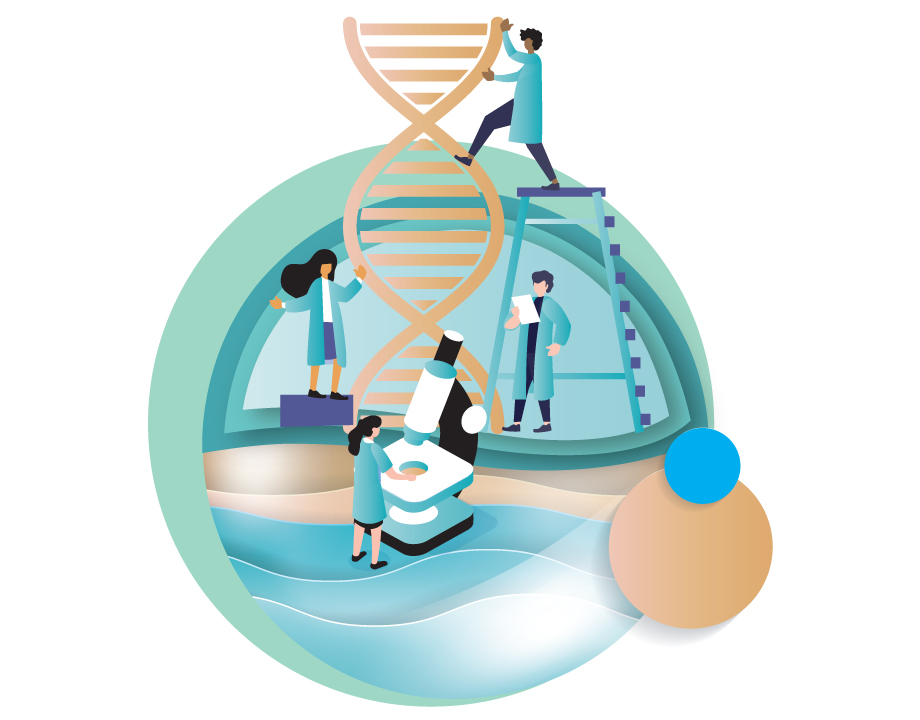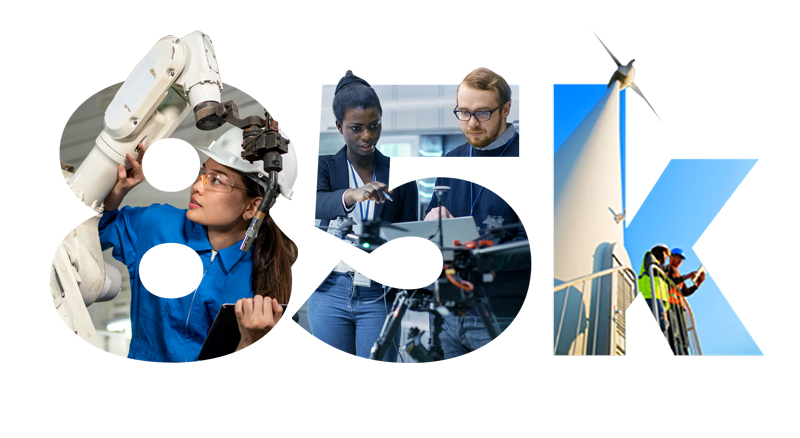Blog: Looking for Sustainable Ways to Build and Break Down Materials
Blog: Looking for Sustainable Ways to Build and Break Down Materials


Researchers search for low-impact ways to replace energy-intensive processes.
When policymakers and thought leaders sketch the outlines of their visions for a sustainable future, it is useful to pull out paper and pencil—or a spreadsheet—to run the numbers. Too often, what sounds good in the abstract can be a non-starter.
Take carbon capture and sequestration. When carbon dioxide’s role as a greenhouse gas became inescapable in the late 1990s, the power industry in the U.S. (and elsewhere) was dominated by coal-fired generating stations. The idea of shuttering them all was unthinkable. Instead, various schemes were developed for capturing carbon dioxide from the flue gas before it entered the atmosphere and then piping it to long-term storage underground. Those carbon-capture systems, using chemical sorbents that must be heated to give up the CO2, would require a lot of power to operate, with an energy penalty of between 20 percent and 30 percent. That meant adding carbon capture to existing plants would increase operating costs to the point where coal power would lose its greatest advantage: price.
Needless to say, carbon capture has yet to be deployed on a large scale. It’s been more economical to replace coal with gas-fired plants or wind and solar farms. That cautionary tale can be retold for a lot of promising technologies. Once the power inputs are penciled in, the benefits disappear.

A recent spate of breakthroughs from research labs across the country promise sustainability without the energy penalty. Rather than push for fast reactions using process heat or electricity, researchers have uncovered processes that can be driven by bacteria or simple catalysts.
For instance, a team of researchers with members from Colorado State University in Fort Collins, Harvard Medical School, and elsewhere has discovered bacteria in hot springs that turn dissolved carbon dioxide into biomass much more quickly than any living organism found to date. The team then sequenced the bacteria’s DNA to try to unlock the secret of what made it so efficient—and perhaps improve on it.
“The project takes advantage of 3.6 billion years of microbial evolution,” said Braden Tierney, the executive director of the Two Frontiers Project and leader of the research team, in a quote from the Guardian. “The nice thing about microbes is that they are self-assembling machines. You don’t have that with a lot of the chemical approaches [to carbon capture].”
More on This Topic: Self-Sustaining Biobattery Keeps the Juice Flowing
Locking the carbon in biomass isn’t the only way bacteria can sequester greenhouse gases. Last year, a team of Spanish researchers explored a cave system that hosted bacteria that consume carbon dioxide and methane from the air, turning it into a calcium-rich carbonate called moonmilk.
Engineers at Northwestern University in Evanston, Ill., recently unlocked the metabolic tricks that enable the Comamonas testosterone bacterium to digest plastics. The team discovered that rather than consuming the complex molecular chains that make up highly engineered plastics, the bacteria first crack open a ring of carbon atoms in the molecule.
“We started with a plastic or lignin compound that has seven or eight carbons linked together through a core six-carbon circular shape forming the so-called benzene ring,” said Ludmilla Aristilde, an associate professor at Northwestern’s McCormick School of Engineering, in a press statement. “Then, they break that apart into shorter chains that have three or four carbons. In the process, the bacteria feed those broken-down products into their natural metabolism, so they can make amino acids or DNA to help them grow.”
By better understanding the process by which bacteria degrade plastics, Aristilde said she hopes to find a pathway to recycle plastic waste into new materials, all without having to tap into petrochemicals.
Another research group, this one based at the Royal Netherlands Institute of Sea Research in 't Horntje, found a bacterium in seawater that seems to be eating the plastics dumped into the oceans. The rate is relatively slow, however—less than the rate that new plastic is entering the ecosystem. The discovery does point to the possibility of using bacteria to clean up the plastic pollution in the ocean in a sustainable manner.
Deep Dive into Biofuels: Fly the Climate-Friendly Skies
Another breakthrough doesn’t rely on bacteria but could lead to more sustainable fertilizer. Engineers at Stanford University in Palo Alto, Calif., have developed a low-temperature, low-pressure method for producing ammonia. Using the common iron-rich mineral magnetite as a catalyst, the researchers created a device that sprayed compressed water and nitrogen gas, producing microdroplets. The catalyst promoted a reaction between the water and nitrogen, producing ammonia.
“To our knowledge, the idea of using gas, liquid, and solid all at the same time to cause a chemical transformation is a first of its kind and has a huge potential for advancing other chemical transformations,” said Richard Zare, the senior researcher involved in the study, according to a press statement.
To be sure, these discoveries need to be fleshed out and the processes optimized. They might all fall afoul of the dreaded pencil and paper problem. On the other hand, these are the sorts of developments that can help industry produce the goods and services consumers rely on without the pollution and climate impact no one wants.
Jeffrey Winters is editor in chief of Mechanical Engineering magazine.
Take carbon capture and sequestration. When carbon dioxide’s role as a greenhouse gas became inescapable in the late 1990s, the power industry in the U.S. (and elsewhere) was dominated by coal-fired generating stations. The idea of shuttering them all was unthinkable. Instead, various schemes were developed for capturing carbon dioxide from the flue gas before it entered the atmosphere and then piping it to long-term storage underground. Those carbon-capture systems, using chemical sorbents that must be heated to give up the CO2, would require a lot of power to operate, with an energy penalty of between 20 percent and 30 percent. That meant adding carbon capture to existing plants would increase operating costs to the point where coal power would lose its greatest advantage: price.
Needless to say, carbon capture has yet to be deployed on a large scale. It’s been more economical to replace coal with gas-fired plants or wind and solar farms. That cautionary tale can be retold for a lot of promising technologies. Once the power inputs are penciled in, the benefits disappear.

A recent spate of breakthroughs from research labs across the country promise sustainability without the energy penalty. Rather than push for fast reactions using process heat or electricity, researchers have uncovered processes that can be driven by bacteria or simple catalysts.
For instance, a team of researchers with members from Colorado State University in Fort Collins, Harvard Medical School, and elsewhere has discovered bacteria in hot springs that turn dissolved carbon dioxide into biomass much more quickly than any living organism found to date. The team then sequenced the bacteria’s DNA to try to unlock the secret of what made it so efficient—and perhaps improve on it.
“The project takes advantage of 3.6 billion years of microbial evolution,” said Braden Tierney, the executive director of the Two Frontiers Project and leader of the research team, in a quote from the Guardian. “The nice thing about microbes is that they are self-assembling machines. You don’t have that with a lot of the chemical approaches [to carbon capture].”
More on This Topic: Self-Sustaining Biobattery Keeps the Juice Flowing
Locking the carbon in biomass isn’t the only way bacteria can sequester greenhouse gases. Last year, a team of Spanish researchers explored a cave system that hosted bacteria that consume carbon dioxide and methane from the air, turning it into a calcium-rich carbonate called moonmilk.
Engineers at Northwestern University in Evanston, Ill., recently unlocked the metabolic tricks that enable the Comamonas testosterone bacterium to digest plastics. The team discovered that rather than consuming the complex molecular chains that make up highly engineered plastics, the bacteria first crack open a ring of carbon atoms in the molecule.
“We started with a plastic or lignin compound that has seven or eight carbons linked together through a core six-carbon circular shape forming the so-called benzene ring,” said Ludmilla Aristilde, an associate professor at Northwestern’s McCormick School of Engineering, in a press statement. “Then, they break that apart into shorter chains that have three or four carbons. In the process, the bacteria feed those broken-down products into their natural metabolism, so they can make amino acids or DNA to help them grow.”
By better understanding the process by which bacteria degrade plastics, Aristilde said she hopes to find a pathway to recycle plastic waste into new materials, all without having to tap into petrochemicals.
Another research group, this one based at the Royal Netherlands Institute of Sea Research in 't Horntje, found a bacterium in seawater that seems to be eating the plastics dumped into the oceans. The rate is relatively slow, however—less than the rate that new plastic is entering the ecosystem. The discovery does point to the possibility of using bacteria to clean up the plastic pollution in the ocean in a sustainable manner.
Deep Dive into Biofuels: Fly the Climate-Friendly Skies
Another breakthrough doesn’t rely on bacteria but could lead to more sustainable fertilizer. Engineers at Stanford University in Palo Alto, Calif., have developed a low-temperature, low-pressure method for producing ammonia. Using the common iron-rich mineral magnetite as a catalyst, the researchers created a device that sprayed compressed water and nitrogen gas, producing microdroplets. The catalyst promoted a reaction between the water and nitrogen, producing ammonia.
“To our knowledge, the idea of using gas, liquid, and solid all at the same time to cause a chemical transformation is a first of its kind and has a huge potential for advancing other chemical transformations,” said Richard Zare, the senior researcher involved in the study, according to a press statement.
To be sure, these discoveries need to be fleshed out and the processes optimized. They might all fall afoul of the dreaded pencil and paper problem. On the other hand, these are the sorts of developments that can help industry produce the goods and services consumers rely on without the pollution and climate impact no one wants.
Jeffrey Winters is editor in chief of Mechanical Engineering magazine.




